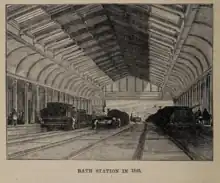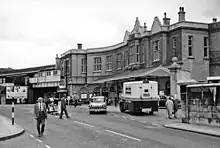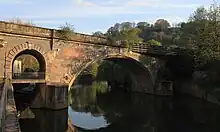Bath Spa railway station
Bath Spa railway station is the principal station serving the city of Bath in South West England. It is on the Great Western Main Line, 106 miles 71 chains (106.89 mi; 172.0 km) down the line from the zero point at London Paddington between Chippenham to the east and Oldfield Park to the west.[2] Its three-letter station code is BTH.
Bath Spa | |
|---|---|
 Main buildings seen from Dorchester Street | |
| General information | |
| Location | Bath, Bath and North East Somerset England |
| Coordinates | 51.3775°N 2.3564°W |
| Grid reference | ST752643 |
| Managed by | Great Western Railway |
| Platforms | 2 |
| Other information | |
| Station code | BTH |
| Classification | DfT category C1 |
| History | |
| Original company | Great Western Railway |
| Pre-grouping | Great Western Railway |
| Post-grouping | Great Western Railway |
| Key dates | |
| 31 August 1840 | Opened as Bath |
| 1949 | Renamed Bath Spa |
| Passengers | |
| 2017/18 | |
| Interchange | |
| 2018/19 | |
| Interchange | |
| 2019/20 | |
| Interchange | |
| 2020/21 | |
| Interchange | |
| 2021/22 | |
| Interchange | |
Listed Building – Grade II* | |
| Official name | BATH SPA STATION |
| Designated | 11 August 1972 |
| Reference no. | 1395629[1] |
| Notes | |
Passenger statistics from the Office of Rail and Road | |
The station is managed by Great Western Railway, who operate all trains at this station.
History


Bath Spa station was built in 1840 for the Great Western Railway by Brunel and is now a Grade II* listed building.[1] It is in an asymmetrical Tudor style with curving gables on the north bank of the Avon where the line curves across from the southern bank to the station and then back again.[3] Opened on 31 August 1840, the station was named Bath and was renamed Bath Spa in 1949 to distinguish it from Bath Green Park station, which did not have its name altered from Bath until 1951.[4]
The station has wide spacing between the platforms because it was built with two broad gauge carriage sidings between the platform lines. The original station featured a hammerbeam roof that covered the area between the platforms, similar to that which still exists at Bristol Temple Meads. However, Bath's roof was removed in 1897 when the station was remodelled with longer platforms.[1][5]
A three-track goods shed was built immediately west of the station, to the north of the main track. In 1877 a goods depot was built about 500 metres to the west at Westmoreland and the goods shed was demolished for the station remodelling in 1897.[5]
A footbridge leads from the rear of the station across the Avon, allowing direct access to the Widcombe area of the city. Open in 1862, the bridge was originally made from wood and tolled (known locally as Halfpenny Bridge). However, this original structure collapsed disastrously in 1877 with a number of deaths, and the present steel girder bridge was erected as a replacement later that same year.[6]
Redevelopment
.JPG.webp)
Since privatisation Great Western Railway has managed Bath Spa. In 2005 the company obtained listed building consent for alterations to the building, including the installation of lifts to the platforms. Ticket barriers have also been installed.[7]
Other developments started in 2011 to integrate the station with the new Bath bus station and SouthGate shopping centre,[8] and redevelop some of the station car park and northern ramp into a restaurant complex at a cost of £12 million.[9] There are plans to adapt some arches at the station to encourage retail use.[10]
Bath Spa won awards for Best Medium-Sized Station and Overall Best Station at the 2013 International Station Awards.[11]
The station was modified in April 2017 for the Great Western Main Line electrification project. Because of its listed status, the platform canopies could not be cut back to fit overhead electrification equipment on the alignment and so the platforms were widened so that future electrification masts could be installed between the tracks. (Electrification through the station was deferred in November 2016). The work provided a larger circulation area and reduced the gap between train and platform.[12]
Other stations in Bath
Railway stations in Bath | ||||||||||||||||||||||||||||||||||||||||||||||||||||||||||||||||||||||||||||||||||||||||||||||||||||||||||||||||
|---|---|---|---|---|---|---|---|---|---|---|---|---|---|---|---|---|---|---|---|---|---|---|---|---|---|---|---|---|---|---|---|---|---|---|---|---|---|---|---|---|---|---|---|---|---|---|---|---|---|---|---|---|---|---|---|---|---|---|---|---|---|---|---|---|---|---|---|---|---|---|---|---|---|---|---|---|---|---|---|---|---|---|---|---|---|---|---|---|---|---|---|---|---|---|---|---|---|---|---|---|---|---|---|---|---|---|---|---|---|---|---|---|
| ||||||||||||||||||||||||||||||||||||||||||||||||||||||||||||||||||||||||||||||||||||||||||||||||||||||||||||||||
The only other open station in Bath is Oldfield Park, a small commuter station in a western suburb, with limited services to Bristol and to Bath Spa, and onward stations.[13]
Former stations now closed in Bath were Green Park (the Midland terminus, whose overall roof and primary buildings survive, and which for part of its life was named "Bath Queen Square"),[14] Bathampton and Weston (a suburban station on the Midland line which closed in 1953). Westmoreland Road was a GWR goods station.[15] Twerton-on-Avon, and Hampton Row Halt, both on the GWR route, closed in 1917 as a World War I economy measure.[16]
Services

All services at Bath Spa are operated by Great Western Railway. They provide regular services between London Paddington and Bristol Temple Meads. These give a service from Bath to Chippenham, Swindon and Reading while some extend beyond Bristol to Weston-super-Mare or Taunton.
There are also services between Cardiff Central and Portsmouth Harbour, and between Great Malvern or Gloucester and Westbury or Weymouth. These provide links to many smaller stations along these lines.[17] Services are mostly operated by Class 165 and Class 166 units.[18]
Civil engineering
The GWR line from London crosses the Avon at the east end of the station, then crosses it again to the west of the station before continuing along a viaduct. Both bridges and the viaduct were originally designed by Brunel, and all are listed buildings.
St James's Bridge

St James's Railway Bridge | |
|---|---|
| Coordinates | 51.3783°N 2.3549°W |
| Carries | GWR Main Line |
| Crosses | River Avon |
| Characteristics | |
| Longest span | 27 m (89 ft) |
| History | |
| Architect | Brunel |
| Opened | c. 1840 |
| Statistics | |
Listed Building – Grade II | |
| Official name | ST JAMES'S RAILWAY BRIDGE |
| Designated | 5 August 1975 |
| Reference no. | 1395151[19] |
The eastern bridge is a elliptical stone arch, with a smaller circular arch either side. It was repaired in brick in 1927. Although not referred to as such, it is a skew bridge, crossing the river at about 45 degrees; it "embodies Brunel's ability to find elegant architectural solutions to engineering challenges."[19]
Skew Bridge

Skew Bridge | |
|---|---|
| Coordinates | 51.3772°N 2.3583°W |
| Carries | GWR main line |
| Crosses | River Avon |
| Characteristics | |
| Material | Stone abutments/pier, with
|
| First section length | 24.38 m (80.0 ft) |
| Second section length | 24.38 m (80.0 ft) |
| History | |
| Designer |
|
| Built | 1840 |
| Rebuilt | 1878 |
| Statistics | |
Listed Building – Grade II | |
| Official name | SKEW BRIDGE AND ASSOCIATED CANTILEVERED WALKWAY IMMEDIATELY TO THE WEST OF BATH SPA STATION |
| Designated | 21 September 2000 |
| Reference no. | 1395344[20] |
Brunel originally intended the Skew Bridge over the Avon to be constructed of cast iron, but he was unable to let the contract for this. Instead, he designed each arch to consist of six arches of laminated timber. Each arch had five laminations of 6 inches (15 cm) thick Baltic pine, bent to shape and held together with bolts and straps of iron.[21] Under the arches, a walkway allowed pedestrians to pass along the south bank of the river; railings were added to the walkway during the 1878 rebuilding.[20]
In 1878, Wakefield Simpson replaced the timber arches with two wrought iron truss spans, supported by iron cylinders which rest on the original piers and abutments. The bridge was strengthened in the 1960s with additional steel supports and superstructure, to allow it to carry the extended platforms of Bath Station.[20][22]
St James' Viaduct

St James' Viaduct | |
|---|---|
| Coordinates | 51.3772°N 2.3600°W |
| Carries | GWR main line |
| Crosses | Lower Bristol Road |
| Other name(s) | Holloway Viaduct, Southgate Viaduct |
| Characteristics | |
| Material | Limestone, brick, steel |
| History | |
| Built | 1840 |
| Opened | 21 Aug 1840 |
| Rebuilt | 1911, 1961 |
| Statistics | |
Listed Building – Grade II* | |
| Official name | St James' Viaduct (MLN110705) |
| Designated | 11 August 1972 |
| Reference no. | 1395135[23] |
After the Skew Bridge, the line continues towards Bristol over St James' Viaduct, a "castellated Gothic fantasy"[24] with pointed arches and arrow slots on the northern (Bath-facing) side; the southern side is plainer. There are seventeen arches in total; the spans crossing Wells Road and Lower Bristol Road were rebuilt in steel in 1911–12 as locomotives had become heavier; the former span was again rebuilt in 1961–62.[23][24]
References
- Historic England. "Bath Spa Station (1395629)". National Heritage List for England. Retrieved 27 December 2011.
- Padgett, David (June 2018) [1989]. Munsey, Myles (ed.). Railway Track Diagrams 3: Western & Wales (6th ed.). Frome: Trackmaps. map 5C. ISBN 978-1-9996271-0-2.
- "Avonside House Design and Access Statement" (PDF). Bath and North East Somerset Council. Archived from the original (PDF) on 26 April 2012. Retrieved 1 January 2012.
- Butt, R.V.J. (1995). The Directory of Railway Stations. Yeovil: Patrick Stephens Ltd. p. 29. ISBN 1-85260-508-1. R508.
- Goods shed, Bath Spa Station, Bath - Historic Building Assessment (PDF) (Report). Oxford Archaeological Unit. 10 March 2000. Archived from the original (PDF) on 23 September 2015. Retrieved 22 February 2015.
- Historic England, Halfpenny Bridge and Lodge House (1394582) Retrieved 12 December 2021
- "Gating proposal for Bath Spa Station ticket hall" (PDF). Bath and North East Somerset Council. Archived from the original (PDF) on 26 April 2012. Retrieved 1 January 2012.
- "Bath Southgate Transport Interchange" (PDF). Southgate Bath. Archived from the original (PDF) on 26 April 2012. Retrieved 1 January 2012.
- "First image of £12m Bath restaurant scheme". Bath Chronicle. 8 December 2011. Archived from the original on 9 January 2012. Retrieved 7 January 2012.
- "Retail Proposals at Bath Spa Railway Station, Bath" (PDF). Oxford Architects. Bath and North East Somerset Council. Archived from the original (PDF) on 26 April 2012. Retrieved 1 January 2012.
- Harris, Nigel, ed. (25 December 2013). "Awards for Bath Spa". Rail. No. 738. Haymarket. p. 12.
- "Modernisation of Bath Spa station". Rail Engineer. Archived from the original on 18 January 2018. Retrieved 17 January 2018.
- "Oldfield Park". The Heart of Wessex Line 2010. Archived from the original on 7 January 2011. Retrieved 1 January 2012.
- "The Midland Railway". Bristol and Bath Railway Path. Archived from the original on 28 November 2011. Retrieved 1 January 2012.
- Maggs, Colin C. (2013). The GWR Bristol To Bath. Amberley Publishing. ISBN 9781445625829. Archived from the original on 26 January 2019. Retrieved 2 May 2017.
- Mike Oakley (2002). Somerset Railway Stations. Dovecote Press, Wimborne. ISBN 1-904349-09-9.
- "Archived copy". Archived from the original on 30 May 2013. Retrieved 8 June 2013.
{{cite web}}: CS1 maint: archived copy as title (link) - "Archived copy". Archived from the original on 22 December 2015. Retrieved 23 August 2013.
{{cite web}}: CS1 maint: archived copy as title (link) - Historic England & 1395151.
- Historic England & 1395344.
- Brindle, Steven (2005). Brunel : the man who built the world. London: Weidenfeld & Nicolson. p. 158. ISBN 0297844083.
- Great Western Main Line Route Structures Gazetteer | Historic England. Alan Baxter & Associates LLP. 18 April 2012. p. 485. Retrieved 4 August 2023.
- Historic England & 1395135.
- Great Western Main Line Route Structures Gazetteer | Historic England. Alan Baxter & Associates LLP. 18 April 2012. p. 487. Retrieved 4 August 2023.